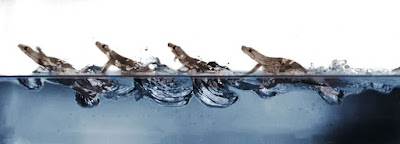 |
| Pauline Jennings, UC Berkeley Courtesy of PolyPEDAL Lab, UC Berkeley |
Topics: Biology, Biophysics, Nanotechnology
Notes:
1. Gecko Nanotechnology, Berger, Michael, Royal Society of Chemistry, Nano Werk dot com
2. Gecko adhesion: evolutionary nanotechnology, Autumn, Kellar; Gravish, Nick, The Royal Society Publishing
Animals famous for walking up walls can also use a combination of techniques to race across water.
The flat-tailed house gecko can not only stick to walls and glide through the air, but also run on water, a new study finds. This discovery of the combination of techniques the reptile uses to race across water could one day lead to robots capable of the same feats, researchers said.
The flat-tailed house gecko (Hemidactylus platyurus) is a common pet reptile native to southern and Southeast Asia. Not only can bristles on its toes help it climb walls and hang from ceilings, but it can glide with the aid of its webbed feet and skin flaps. "They're kind of like superheroes -- every time you look at them, they can do more things," said study senior author Robert Full, an integrative biologist at the University of California, Berkeley.
The newfound talent of this species was discovered by study co-author Ardian Jusufi, a biophysicist now at the Max Planck Institute for Intelligent Systems in Stuttgart, Germany, when he was in a rain forest in Singapore and saw the geckos skidding across puddles to escape predators. Lab experiments with these reptiles found they could run up to nearly a meter per second over 8 centimeters of water, faster than the swimming speeds of many aquatic creatures, including ducks, muskrats, juvenile alligators and marine iguanas. They could also easily switch to dashing across solid ground or scampering up a wall.
How Geckos Run on Water, Charles Q. Choi, Inside Science
Comments